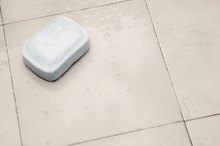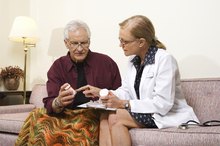Best Over-The-Counter Antibiotic Ointments
Cuts and scrapes happen to everyone 1. Information provided by the American Academy of Family Physicians notes that most minor wounds heal well without applying an over-the-counter antibiotic ointment or cream. Use of one of these products or an adhesive bandage, however, might help prevent an infection that could delay healing or lead to scarring. Three major types of over-the-counter antibiotic ointments are available. Some are also available as creams. The primary difference between these products is the number of antibiotics they contain. Products with multiple antibiotics protect against a broader range of bacteria that might cause an infection related to a skin wound.
Bacitracin
Bacitracin is a key ingredient in over-the-counter antibiotic ointments and creams 46. First discovered in 1945, bacitracin is an antibiotic that effectively kills a broad range of bacteria 4. It is particularly effective against staphylococcal and streptococcal bacteria, which are most commonly to blame for skin infections. Bacitracin is used almost exclusively used as a topical antibiotic 4. It sometimes causes a skin reaction known as contact dermatitis, characterized by redness, swelling and itching. This reaction might delay wound healing. Rarely, a severe allergic reaction called anaphylaxis can occur. Several brands of bacitracin-only antibiotic ointments are available over the counter 46.
Bacitracin and Polymyxin B
What Foods Have Zinc and Cobalt in Them?
Learn More
Double antibiotic ointments and creams contain bacitracin plus polymyxin B. Polysporin is a brand name, over-the-counter ointment containing this antibiotic mixture 246. Many generic versions are also available. Like bacitracin, polymyxin B is used almost exclusively as a topical antibiotic 46. Polymyxin B is effective against many types of bacteria in the group known as the gram-negative rods, many of which are not inhibited by bacitracin 4. Therefore, double antibiotic ointments and creams offer broader antibacterial coverage than bacitracin alone 4. Similar to bacitracin, topical polymyin B can also cause contact dermatitis and, rarely, anaphylaxis 458.
Bacitracin, Polymyxin B and Neomycin
Triple antibiotic ointments contain bacitracin, polymyxin B and neomycin 469. Both a brand name product (Neosporin) and multiple generic versions are available over the counter. Neomycin belongs to the class of antibiotics called aminoglycosides 10. Neomycin is generally active against the same types of bacteria as the combination of bacitracin plus polymyxin B 4910. The addition of neomycin to the double antibiotic combination is believed to enhance effectiveness through an additive effect 10. Topical neomycin can trigger contact dermatitis and, rarely, anaphylaxis 510.
Warnings and Precautions
Antibiotics for a Puncture Wound
Learn More
Over-the-counter antibiotic ointments and creams are generally considered safe and effective for minor, shallow wounds. However, they should not be used for deep cuts or puncture wounds. Additionally, there is some concern that widespread use of these products might contribute to growing antibiotic resistance of bacteria, as reported in an October 2011 article in “Emerging Infectious Diseases.” Talk with your doctor about possible risks and benefits of using these products for minor cuts and scrapes.
Seek medical attention if you sustain a skin wound on your face or a gaping cut elsewhere on your body. Immediate medical attention is needed if you sustain a skin wound caused by a human or animal bite, or the wound contains dirt or other debris that you cannot easily remove. Seek urgent medical care if your injury is not improving within 3 to 5 days, or you have signs or symptoms that could indicate a serious injury or infection, including: -- bleeding that persists for more than 15 to 20 minutes, especially if it occurs in spurts coinciding with your heartbeat -- numbness, or spreading redness or tenderness around the wound -- pus or thick fluid drainage from the wound -- fever or chills
Reviewed and revised by: Tina M. St. John, M.D.
- Over-the-counter antibiotic ointments and creams are generally considered safe and effective for minor, shallow wounds.
- Seek urgent medical care if your injury is not improving within 3 to 5 days, or you have signs or symptoms that could indicate a serious injury or infection, including: -- bleeding that persists for more than 15 to 20 minutes, especially if it occurs in spurts coinciding with your heartbeat -- numbness, or spreading redness or tenderness around the wound -- pus or thick fluid drainage from the wound -- fever or chills Reviewed and revised by: Tina M. St. John, M.D.
Related Articles
References
- FamilyDoctor.org: First Aid: Cuts, Scrapes, and Stitches
- DailyMed: Bacitracin -- Bacitracin Zinc Ointment
- Pharmacy Times: Bacitracin and Boo-Boos: Becoming a No-No
- DrugBank: Bacitracin
- DailyMed: Polysporin First Aid Antibiotic -- Bacitracin and Polymyxin B Sulfate Ointment
- DrugBank: Polymyxin B Sulfate
- Dermatitis: Contact Allergy to Polymyxin B Among Patients Referred for Patch Testing
- DailyMed: Neosporin Original -- Bacitracin Zinc, Neomycin Sulfate, and Polymyxin B Sulfate Ointment
- Drug Bank: Neomycin
Resources
Writer Bio
Nicole Brown began writing professionally for Java Joint Media in 2007. She has published two "how-to" books through Atlantic Publishing Group. Brown is a state-tested nursing assistant with two years of experience in the health care field. She graduated from the University of Rio Grande with a Bachelor of Science in communications/public relations in 1999.









